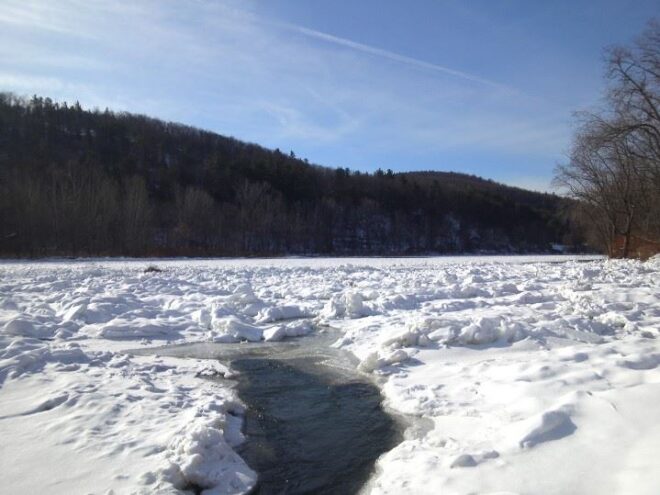by Brianna Riesbeck, Volunteer.
February is the month where cabin fever seems to hit the hardest. The holiday rush and glow of the New Year are over and now we’re beginning the painfully long trudge towards spring. Hibernation has truly never sounded more appealing. But rather than hunkering down for a long winter’s nap, many of us feel the pull to nature despite the bitter cold. There’s a unique thrill in taking advantage of the empty hiking trails or the open river when many people are opting to stay in and stay warm. And that willingness to sacrifice personal comforts for time outdoors can do wonders for our health. In a 2019 study done by the European Centre for Environment & Human Health concluded that spending two hours per week out in green spaces resulted in higher reports of good health and psychological well-being than those who did not. And although our New York winters don’t provide much in the way of “green” space, the fresh air and sunshine are beneficial nonetheless.
Believe it or not, people are still out on the river during the winter! And there are plenty of perks to getting out there aside from the health benefits. You could head out to your favorite spot and enjoy a new spin on the scenery as deciduous trees lose their foliage and open up the landscape for a totally different experience. Fewer people on the river also means more space to maneuver where you’d like and enjoy the quiet. It’s also just a refreshing new way to enjoy your morning coffee! Taking a hot thermos of your favorite beverage out onto the river sounds like a great start to the day. That’s not to say that winter paddling doesn’t come with a fair amount of risks. Tipping over in the summer is a much more forgiving blunder than immersion in the cold winter water. For that reason, taking extra precautions is imperative for a safe and successful aquatic excursion.
If you’re looking to enjoy the winter river scene, you need to have river experience. Cold weather kayaking requires more knowledge and skill. and the risk of kayaking in cold water is far greater for inexperienced kayakers who may not know how to recover in case of immersion. No matter how good your personal watercraft is, it can tip at any time. When it comes to immersion in cold water, there’s a 1-10-1 rule: you have one minute to get your breathing under control after a cold water shock, 10 minutes to get yourself out of the water before muscle incapacitation, and 1 hour before unconsciousness sets in due to hypothermia. That’s not a ton of time, especially if you’re inexperienced. Knowing how to properly right yourself and get back in your vessel is essential.
If you live in the northeast, it goes without saying: dressing properly for the cold weather is critical to enjoying (and surviving) any outdoor activities. The standard protocol for cold weather clothing is to dress in layers. Your base layer should always be a moisture-wicking material that pulls moisture away from your skin and keeps you dry. This has traditionally been wool but there are plenty of synthetic materials that achieve that same outcome. Cotton is not a suitable base layer as it takes too long to dry. Your next layer should be a heavier insulating material to retain body heat. This could be a combination of fleece and a puffy jacket but any clothing that retains heat will work. The final layer should be a waterproof outer shell. Ideally, this will be a dry-suit which leaves plenty of room for layers but cinches at the wrists, ankles and neck to keep as much water out as possible. It may feel like an unnecessary extra expense but it is well worth the money in order to stay warm and safe. In addition to insulating your core, be sure to wear proper waterproof gloves and a head covering, as well as a good pair of waterproof boots. And last but certainly not least, wear your PFD. Life vests will give you a much better chance of righting yourself and getting out of the water in case of immersion.
Now that you’re properly dressed, it’s time to think about what to bring with you. Almost everything you pack should be stored in a dry bag. This should have all of your personal items as well as your emergency supplies. Cold weather must-haves include a set of thermal underclothes, a thermal blanket, emergency heat packs and a thermos of hot water or some other hot beverage. It’s also important to equip your kayak with a neoprene spray skirt to keep cold water out and keep your body heat in. On the topic of bringing things, bring a friend! Solo paddling may sound appealing but having at least three people out on the water together is best. That way, one person can call for help while the other physically assists if someone has fallen in the water. Let people know where you’re going and how long you expect to be out on the water. Keep some form of communication device in dry bag, that floats and is attached to you, for emergencies. And most importantly, take your time. Rushing can lead to fatal mistakes in freezing temperatures. Steer clear of obstacles and be cautious when getting in and out of your kayak.
Winter doesn’t mean that you need to sacrifice your time outdoors or even on the river. It does mean that extra precautions need to be taken to ensure your safety. If you’re planning on heading out on the river this winter, be sure that you’re taking the proper steps to make your outing a successful one. Be safe and be healthy!
